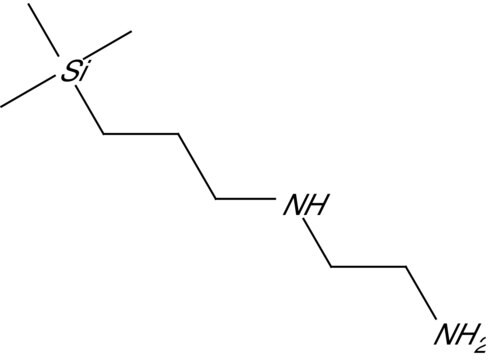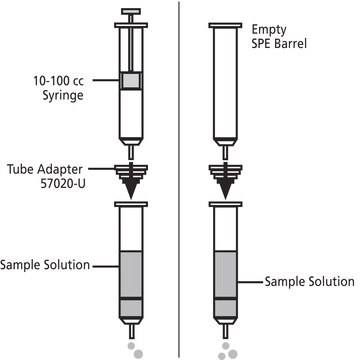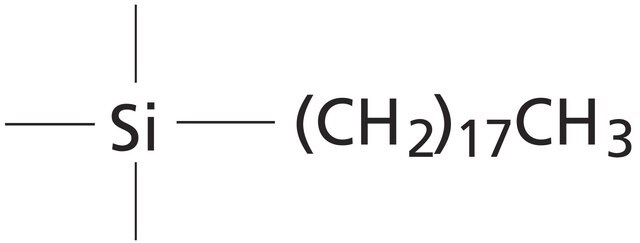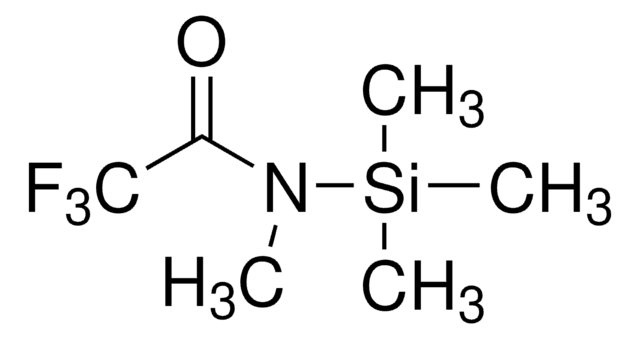53210-U
SupelMIP® Chloramphenicol solid phase extraction (SPE) Tube
bed wt. 25 mg, volume 10 mL , LRC, pk of 50
About This Item
Productos recomendados
Nombre del producto
SupelMIP® SPE - Cloranfenicol, bed wt. 25 mg, volume 10 mL , LRC, pk of 50
Materiales
polypropylene tube
Nivel de calidad
Línea del producto
SupelMIP®
composición
bed wt., 25 mg
envase
pk of 50
técnicas
solid phase extraction (SPE): suitable
volumen
10 mL , LRC
aplicaciones
food and beverages
¿Está buscando productos similares? Visita Guía de comparación de productos
Categorías relacionadas
Descripción general
The SupelMIP SPE line consist s of highly cross-linked polymers that are engineered to extract a single analyte of interest or a class of structurally related analytes with an extremely high degree of selectivity. This is possible because selectivity is introduced during MIP synthesis in which a template molecule, designed to mimic the analyte, guides the formation of specific cavities or imprints that are sterically and chemically complementary to the analyte(s) of interest.
By careful design of the imprinting site, either by molecular modeling, experimental design, or screening methods, the binding cavities can be engineered to offer multiple interaction points with the analyte(s) of interest. This leads to a stronger interaction between the solid-phase and the analyte(s). As a consequence, harsher wash conditions can be tolerated during SPE methodology resulting in cleaner extracts. Because extraction selectivity is significantly improved, lower background is observed allowing analysts to achieve lower limits of detection.
Visit www.sigma-aldrich.com/supelmip to learn more.
Aplicación
Chloramphenicol is a broad-spectrum antibiotic that is currently banned by a number of countries including the EU, the US, and Canada. This MIP phase and associated method offer a simple, efficient, and highly selective extraction method for quantiting chloramphenicol in food products and biological matrices. Detection limits well below the minim required performance limit (MPRL) are achieved consistently.
Características y beneficios
- Highly selective SPE for trace analysis in complex matrices
- Achieve lower detection limits
- Significant time and cost savings
- Improved MS-compatibility
Información legal
¿No encuentra el producto adecuado?
Pruebe nuestro Herramienta de selección de productos.
Aplicación
Palabra de señalización
Danger
Frases de peligro
Consejos de prudencia
Clasificaciones de peligro
Acute Tox. 4 Oral - Aquatic Acute 1 - Aquatic Chronic 2 - Eye Dam. 1 - STOT SE 3
Órganos de actuación
Respiratory system
Código de clase de almacenamiento
10 - Combustible liquids
Clase de riesgo para el agua (WGK)
WGK 1
Punto de inflamabilidad (°F)
200.3 °F
Punto de inflamabilidad (°C)
93.5 °C
Elija entre una de las versiones más recientes:
¿Ya tiene este producto?
Encuentre la documentación para los productos que ha comprado recientemente en la Biblioteca de documentos.
Artículos
The method for determination of low concentrations of chloramphenicol in bovine and porcine urine was developed. Sample cleanup was performed by Molecular Imprinted Polymer (MIP) columns. Confirmatory analyses were conducted using GC/MS-NCI after derivatisation (silylation). The described method was fully validated according to CD 2002/657/EC, CCa was 0.06 ng/mL, CCb was 0.1 ng/mL. This method is considerably robust and allows to process even very dirty samples. The described procedure is very simple, low-time-consuming, provides high throughput of examinated samples, and could be used for routine screening and confirmatory analyses as well.
Contenido relacionado
SupelMIP SPE is based on molecularly imprinted polymer (MIP) technology. Each SupelMIP phase offers tailor-made selectivity for the extraction of trace analytes in complex matrixes.
Chromatograms
application for SPE, application for LC-MSNuestro equipo de científicos tiene experiencia en todas las áreas de investigación: Ciencias de la vida, Ciencia de los materiales, Síntesis química, Cromatografía, Analítica y muchas otras.
Póngase en contacto con el Servicio técnico











